Shakti
Shakti is a chess variant, invented by Christian Freeling in 1982. Shakti is Christian's smallest chess variants. There is a computer program that plays Shakti against humans; this program runs on a Macingtosh. Christian wrote me that, while the program implements some rules incorrectly (e.g., it does not recognize mate, but continues till the king is taken), it is a rather strong program. Follow this link for more information on the program.
The description of the rules of Shakti below is taken from the website of Christian Freeling and Ed van Zon (with permission) (slightly edited by me); and also the pictures were taken from this website, called Mindsports.
See the Mindsports website for more information on Christian Freeling's other chess variants, methods to play several of these on the Internet against others, and more.
Rules
Shakti is played by two players on a seven by seven board. Each player has one king and two warriors. The starting setup is shown below.
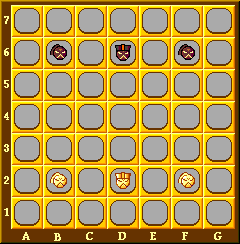 White:
White:
King d2; Warrior b2, f2.
Black:
King d6; Warrior b6, f6.
Initially, the board is covered with 49 tiles.
All play is on the tiles.
White begins. Players move, and must move unless they cannot, in turn.
A player who cannot move is either checkmate or stalemate. In the first case the game is over. (As in chess and most chess variants, the player that mated his opponent wins, and the checkmated player loses.) In the second case the other player moves again, i.e., unlike chess, when a player is stalemated, he just loses his turn.
The King, if not in check, may move to the first tile he sees in any of eight directions, see the diagram below.
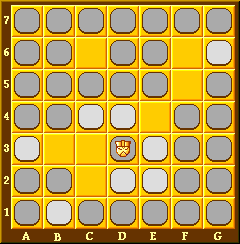
For the moment we'll anticipate on the warrior's
move.
If in check, the King is restricted to adjacent tiles. Pieces giving check
from a distance therefore need no protection, see the diagram below. It
follows that the King can only capture an unprotected warrior on a straight
or diagonally adjacent tile.
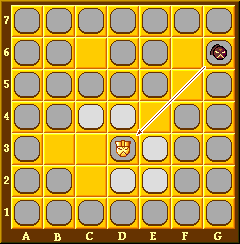
The mutual check rule: King's may not face one another along the same rank, file or diagonal, with no tiles in between. It follows that a King may protect a warrior it sees, as in the next diagram, where the black King has but one option.
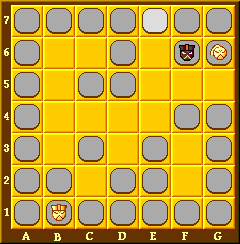
A warrior may move to the first tile it sees in any of eight directions. If both are vacant, a warrior may also move to the second tile, removing the first. The removal is compulsory, but of course the player may not, in doing so, put his own King in check (so if this were the case, the warrior may not move to the second tile). The next diagram shows the warrior's options. If he chooses a second target-tile in any particular direction, the first one is removed. The black King is not in check because the vacancy-condition is not fulfilled.
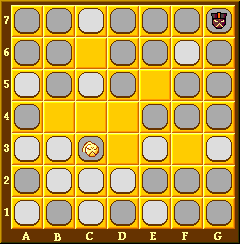
Warriors are strictly King oriented and cannot capture one another.
Rules written by Christian Freeling for the Mindsports Website, slightly edited for the Chess Variant Pages, and introduction and comments added by Hans Bodlaender. Rules and images copyright Mindsports; used here with permission.
WWW page made: November 14, 1997.
